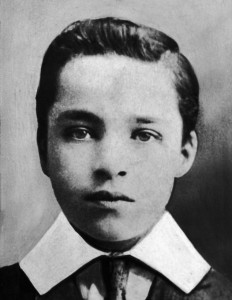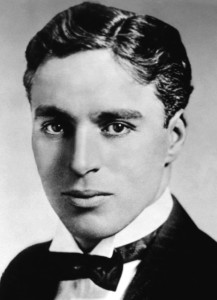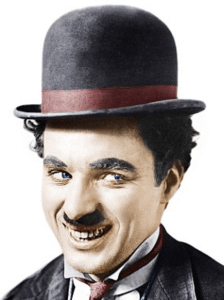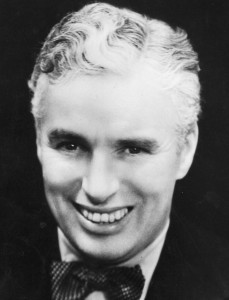Charlie Chaplin
Charles Spencer “Charlie” Chaplin (16 April 1889 – 25 December 1977) was an English comic actor, filmmaker, and composer who rose to fame in the silent era. Chaplin became a worldwide icon through his screen persona “The Tramp” and is considered one of the most important figures in the history of the film industry.
Charlie Chaplin’s rise to fame is a true rags-to-riches story. His father, a notorious drinker, abandoned Chaplin, his mother, and his older half-brother, Sydney, not long after Chaplin’s birth. That left Chaplin and his brother in the hands of their mother Hannah, a vaudevillian and music hall singer who went by the stage name Lily Harley.
 Chaplin’s mother was able to support her family for a few years. In a performance that would introduce her youngest boy to the spotlight, Hannah inexplicably lost her voice in the middle of a show, prompting the production manager to push the five-year-old Chaplin, whom he’d heard sing, onto the stage to replace her.
Chaplin’s mother was able to support her family for a few years. In a performance that would introduce her youngest boy to the spotlight, Hannah inexplicably lost her voice in the middle of a show, prompting the production manager to push the five-year-old Chaplin, whom he’d heard sing, onto the stage to replace her.
Chaplin lit up the audience, wowing them with his natural presence and comedic angle (at one point he imitated his mother’s cracking voice). But the episode meant the end for Hannah. Her singing voice never returned, and she eventually ran out of money. For a time, Charlie and Sydney had to make a new, temporary home for themselves in London’s tough workhouses.
Armed with his mother’s love of the stage, Chaplin was determined to make it in show business himself, and in 1897, using his mother’s contacts landed with a clog-dancing troupe named the Eight Lancashire Lads. It was a short stint, and not a terribly profitable one, forcing the go-getter Chaplin to make ends meet any way he could.
“I was newsvendor, printer, toymaker, doctor’s boy, etc., but during these occupational digressions, I never lost sight of my ultimate aim to become an actor,” Chaplin later recounted. “So, between jobs, I would polish my shoes, brush my clothes, put on a clean collar, and make periodic calls at a theatrical agency.”
Eventually, other stage work did come his way. Chaplin made his acting debut as a pageboy in a production of Sherlock Holmes. From there he toured with a vaudeville outfit named Casey’s Court Circus and in 1908 teamed up with the Fred Karno pantomime troupe, where Chaplin became one of its stars as the Drunk in the comedic sketch A Night in an English Music Hall.
With the Karno troupe, Chaplin got his first taste of the United States, where he caught the eye of film producer Mack Sennett, who signed Chaplin to a contract for $150 a week.
 In 1914 Chaplin made his film debut in a somewhat forgettable one-reeler called Make a Living. To differentiate himself from the clad of other actors in Sennett’s films, Chaplin decided to play a single identifiable character, and “The Little Tramp” was born, with audiences getting their first taste of him in Kid Auto Races at Venice (1914).
In 1914 Chaplin made his film debut in a somewhat forgettable one-reeler called Make a Living. To differentiate himself from the clad of other actors in Sennett’s films, Chaplin decided to play a single identifiable character, and “The Little Tramp” was born, with audiences getting their first taste of him in Kid Auto Races at Venice (1914).
Over the next year, Chaplin appeared in 35 movies, a lineup that included Tillie’s Punctured Romance (video), the film’s first full-length comedy. In 1915 Chaplin left Sennett to join the Essanay Company, which agreed to pay him $1,250 a week. It is with Essanay that Chaplin, who by this time had hired his brother Sydney to be his business manager, rose to stardom.
During his first year with the company, Chaplin made 14 films, including The Tramp (1915). Generally regarded as the actor’s first classic, the story establishes Chaplin’s character as the unexpected hero when he saves the farmer’s daughter from a gang of robbers.
 By the age of 26, Chaplin, just three years removed from his vaudeville days, was a superstar. He’d moved over to the Mutual Company, which paid him a whopping $670,000 a year. The money made Chaplin a wealthy man, but it didn’t seem to derail his artistic drive.
By the age of 26, Chaplin, just three years removed from his vaudeville days, was a superstar. He’d moved over to the Mutual Company, which paid him a whopping $670,000 a year. The money made Chaplin a wealthy man, but it didn’t seem to derail his artistic drive.
With Mutual, he made some of his best works, including “The Floorwalker“, “The Fireman“(video), “The Vagabond“, “One A.M.” (a production in which he was the only character for the entire two reels with the exception of the entrance of a cab driver in the opening scene), “The Count” (view film), “The Pawnshop“, “Behind the Screen“, “The Rink“, “Easy Street” (heralded as his greatest production up to that time), “The Cure“, “The Immigrant” and “The Adventurer“.
When his contract with Mutual expired in 1917, Chaplin decided to become an independent producer in a desire for more freedom and greater leisure in making his movies. To that end, he busied himself with the construction of his own studios. This plant was situated in the heart of the residential section of Hollywood at La Brea Avenue.
Early in 1918, Chaplin entered into an agreement with First National Exhibitors’ Circuit, a new organization specially formed to exploit his pictures. His first film under this new deal was “A Dog’s Life” (view film). After this production, he turned his attention to a national tour on behalf of the war effort, following which he made a film the US government used to popularize the Liberty Loan drive: “The Bond” (view film).

His next commercial venture was the production of a comedy dealing with the war. “Shoulder Arms“, released in 1918 at a most opportune time, proved a veritable earthquake at the box office and added enormously to Chaplin’s popularity. This he followed with “Sunnyside” and “A Day’s Pleasure“, both released in 1919.
In April of that year, Chaplin joined with Mary Pickford, Douglas Fairbanks, and D.W. Griffith to found the United Artists Corporation. However, before he could assume his responsibilities with United Artists, Chaplin had to complete his contract with First National.
So early in 1921, he came out with a six-reel masterpiece: The Kid, in which he introduced to the screen one of the greatest child actors the world has ever known – Jackie Coogan. The next year, he produced “The Idle Class“, in which he portrayed a dual character.
Then, feeling the need for a complete rest from his motion picture activities, Chaplin sailed for Europe in September 1921. London, Paris, Berlin, and other capitals on the continent gave him tumultuous receptions. After an extended vacation, Chaplin returned to Hollywood to resume his picture work and start his active association with United Artists.
Under his arrangement with U.A., Chaplin made eight pictures, each of feature-length.
A Woman of Paris (1923) was a romantic drama. The inspiration came from three women – in particular Edna Purviance, who had been his ideal partner in more than 35 films. Now, though, he felt that Edna was growing too mature for comedy, and decided to make a film that would launch her on a new career as a dramatic actress.
The Gold Rush (1925) stars Chaplin in his Little Tramp persona. Lita Grey, whom Chaplin married in mid-1924, was originally cast as the leading lady but was replaced by Georgia Hale. Chaplin declared several times that this was the film for which he most wanted to be remembered. Though it was a silent film, it received Academy Award nominations for Best Music and Best Sound Recording upon its re-release in 1942. View trailer.
City Lights (1931) proved to be the hardest and longest undertaking of Chaplin’s career. By the time it was completed he had spent two years and eight months on the work, with almost 190 days of actual shooting. Even though the sound film was firmly established he made it as a silent film like all his previous films. However, he astounded the press and the public by composing the entire score for the film. The premieres were among the most brilliant the cinema had ever seen. “City Lights” was a critical triumph. All Chaplin’s struggles and anxieties, it seemed, were compensated by the film which still appears as the zenith of his achievement and reputation. View trailer.
Modern Times (1936)
Chaplin was acutely preoccupied with the social and economic problems of this new age. In Europe, he had been disturbed to see the rise of nationalism and the social effects of the Depression, unemployment, and of automation. Chaplin devised his own Economic Solution, an intelligent exercise in utopian idealism, based on a more equitable distribution not just of wealth but of work. “Unemployment is the vital question . . . Machinery should benefit mankind. It should not spell tragedy and throw it out of work”.
The Great Dictator (1940) pointedly ridiculed the governments of Hitler and Mussolini. “I want to see the return of decency and kindness,” Chaplin decided to pit his celebrity and humor against Hitler’s own celebrity and evil. Chaplin plays a dual role –a Jewish barber and Adenoid Hynkel, the dictator. Chaplin’s aim is obvious, and the film ends with a now-famous and humanitarian speech made by the barber, “speaking Chaplin’s own words”.
Monsieur Verdoux (1947)
The idea was originally suggested by Orson Welles, as a project for a dramatized documentary on the career of the legendary French murderer Henri Désiré Landru – who was executed in 1922, having murdered at least ten women, two dogs, and one boy. Chaplin was so intrigued by the idea that he paid Welles $5000 for it. The agreement was signed in 1941, but Chaplin took four more years to complete the script.
In the late 1940s, America¹s Cold War paranoia reached its peak, and Chaplin, as a foreigner with liberal and humanist sympathies, was a prime target for political witch-hunters. This was the start of Chaplin’s last and unhappiest period in the United States, which he was definitively to leave in 1952.
Limelight (1952)
Chaplin found the theme in bitter-sweet nostalgia for the world of his youth – the world of the London music halls at the opening of the 20th century, where he had first discovered his genius as an entertainer. The main character Calvero had a very similar childhood to Chaplin’s own. Limelight’s story of a once-famous music hall artist whom nobody finds amusing any longer may well have been similarly autobiographical as a sort of nightmare scenario. Several members of the Chaplin family participated in the film. It was when on the boat traveling with his family to the London premiere of Limelight that Chaplin learned that his re-entry pass to the United States had been rescinded based on allegations regarding his morals and politics.
A King in New York (1957)
In this film, Chaplin exposed, through satire and ridicule, the paranoia and political intolerance which overtook the United States in the Cold War years of the 1940s and 50s. Chaplin himself had a bitter personal experience of the American malaise of that time. To take up filmmaking again, as an exile, was a challenging undertaking. The film shows the strain.
A Countess from Hong Kong (1966)
This film in color with Sophia Loren and Marlon Brando was unsuccessful at the box office, but Petula Clark had one or two hit records with songs from the soundtrack music and the music continues to be very popular.
Through his work, Chaplin came to be known as a grueling perfectionist. His love for experimentation often meant countless takes, and it was not uncommon for him to order the rebuilding of an entire set. Nor was it uncommon for him to begin filming with one leading actor, realize he’d made a mistake in his casting, and start again with someone new.
Chaplin became equally famous for his life off-screen. His affairs with actresses who had roles in his movies were numerous. Some, however, ended better than others.
In 1918 he quickly married 16-year-old Mildred Harris. The marriage lasted just two years, and in 1924 he wed again, to another 16-year-old, actress Lita Grey, whom he’d cast in The Gold Rush. The marriage had been brought on by an unplanned pregnancy, and the resulting union, which produced two sons for Chaplin (Charles Jr. and Sydney) was an unhappy one for both partners. They divorced in 1927.
In 1936, Chaplin married again, this time to a chorus girl who went by the film name of Paulette Goddard. They lasted until 1942. That was followed by a nasty paternity suit with another actress, Joan Barry, in which tests proved Chaplin was not the father of her daughter, but a jury still ordered him to pay child support.
In 1943, Chaplin married 18-year-old Oona O’Neill, the daughter of playwright Eugene O’Neill. Unexpectedly the two would go on to have a happy marriage, one that would result in eight children.
But Chaplin was not universally embraced. His romantic liaisons led to his rebuke by some women’s groups, which in turn led to him being barred from entering some U.S. states. As the Cold War age settled into existence, Chaplin didn’t withhold his fire from injustices he saw taking place in the name of fighting Communism in his adopted country of the United States.
Chaplin soon became a target of the right-wing conservatives. Representative John E. Rankin of Mississippi pushed for his deportation. In 1952, the Attorney General of the United States obliged when he announced that Chaplin, who was sailing to Britain on vacation, would not be permitted to return to the United States unless he could prove “moral worth.” The incensed Chaplin said goodbye to the United States and took up residence on a small farm in Corsier-sur-Vevey, Switzerland.
Nearing the end of his life, Chaplin did make one last visit to the United States in 1972, when he was given an honorary Academy Award. In 1975, Chaplin received further recognition when he was knighted by Queen Elizabeth.
Chaplin’s versatility extended to writing, music, and sports. He was the author of at least four books, “My Trip Abroad”, “A Comedian Sees the World”, “My Autobiography”, “My Life in Pictures” as well as all of his scripts. An accomplished musician, though self-taught, he played a variety of instruments with equal skill and facility (playing violin and cello left-handed).
He was also a composer, having written and published many songs, among them: “Sing a Song”; “With You Dear in Bombay”; and “There’s Always One You Can’t Forget”, “Smile”, “Eternally”, “You are My Song”, as well as the soundtracks for all his films, Charles Chaplin was one of the rare comedians who not only financed and produced all his films (with the exception of “A Countess from Hong Kong”), but was the author, actor, director and soundtrack composer of them as well.
In the early morning hours of December 25, 1977, Charlie Chaplin died at his home in Corsier-sur-Vevey, Vaud, Switzerland. His wife, Oona, and seven of his children were at his bedside at the time of his passing. In a twist that might very well have come out of one of his films, Chaplin’s body was stolen not long after he was buried from his grave near Lake Geneva in Switzerland by two men who demanded $400,000 for its return. The men were arrested and Chaplin’s body was recovered 11 weeks later.
Links:
Quotes by Charlie Chaplin
–
A day without laughter is a day wasted.
–
Laughter is the tonic, the relief, the surcease for pain.
–
I have many problems in my life. My lips don’t know that. – They always smile.
–
The saddest thing I can imagine is to get used to luxury.
–
Failure is unimportant. It takes courage to make a fool of yourself.
–
We think too much and feel too little.
–
Life is a desire, not a meaning.
–
You’ll find that life is still worthwhile, if you just smile.
–
Imagination means nothing without doing.
–
I believe in the power of laughter and tears as an antidote to hatred and terror.
–
Life is a play that does not allow testing. So, sing, cry, dance, laugh and live intensely, before the curtain closes and the piece ends with no Applause.
–
Man as an individual is a genius. But men in the mass form the headless monster, a great, brutish idiot that goes where prodded.
–
We all want to help one another. Human beings are like that. We want to live by each other’s happiness, not by each other’s misery.
–
You need Power, only when you want to do something harmful, otherwise Love is enough to get everything done.
–
Think about yourself at least once in your life, otherwise you may miss the best comedy in this world.
–


